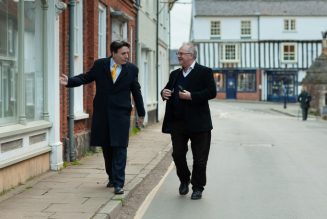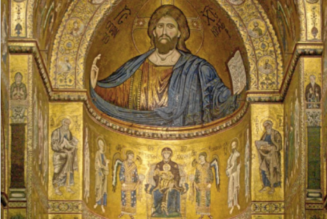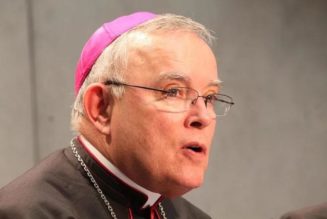
One enduring question facing the Church is how to engage the modern world. Gaudium et Spes called for a new era of openness and dialogue,[1] while Pope Paul VI warned that “the split between the Gospel and culture is without a doubt the drama of our time, just as it was of other times.” For many Christians, this split seems rather obvious: popular movies and music brazenly defy Christian norms, while schools and corporations embrace late modern dogmas that are antithetical to Christianity.
Yet narrowing one’s focus to such examples prevents a fuller appreciation of what culture is, how it influences people, and what it means to be secular, or “of the age.” What follows draws on sociological models of culture and St. John Paul II’s critique of the “culture of death” to offer a deeper understanding of how modern culture works to secularize Christians—even those who maintain religious belief and practice.
Misunderstanding Culture
Raymond Williams claimed that “culture is one of the two or three most complicated words in the English language.”[2] Culture is often defined by its various features: beliefs, norms, values, narratives, frameworks, and vocabularies. But how do these aspects of culture become internalized, thereby shaping how people live? Many people seem to imagine that culture is transmitted primarily through the overt messages of the media, religious authorities, teachers, and parents.
When analyzing the predominant messaging of modern culture, it is not difficult to recognize strands of consumerism, individualism, and relativism. Scholars, pastors, and journalists regularly criticize these features of culture, and their audiences have little difficulty calling to mind examples from Hollywood, higher education, or advertising. Well-meaning cultural critics may imagine their mission as evaluating the content of such messaging and combatting it with Christian messages, whether in the form of homilies, lectures, or Christian media.
Yet this model of cultural transmission is far too simplistic. Of course, culture can be passed on through overt messages such as sermons or lectures, but research indicates such modes of transmission are somewhat limited. Cognitive psychology suggests most human behavior is not the result of intentional deliberation, but is guided by dispositions we accumulate through the practices and routines of everyday life.[3] Sociological research finds culture’s effects to be most enduring when transmitted through more subtle means: traditions, rituals, practices, and unspoken assumptions that quietly shape people’s vision of the world and their lives.[4]
For this reason, the primary challenge of modern culture is not that it contains anti-Christian messaging. After all, those who have received basic catechesis should be able to discern when overt messages are immoral. Instead of focusing solely on how bad ideas and values might infiltrate people’s minds through a sort of osmosis, Catholics ought to be more wary of how everyday social practices might initiate them into ways of thinking, feeling, and acting that undermine the necessary virtues of the Christian faith.
How the Culture of Death Secularizes Christians
This model of cultural transmission allows for a deeper understanding of modern secularity. Headlines regularly decry declines in religiosity and the failings of Christian leaders and institutions, yet the secular character of the modern age goes much deeper. Charles Taylor argues that secularization is more than a loss of religious belief and practice, but includes the adoption of a secular social imaginary—where people imagine the world and their lives through an immanent frame, no matter their beliefs.
Well before Taylor’s A Secular Age was published St. John Paul II—the “philosopher pope”—also explored the ways that secularity and faith can coexist. While his vision is similar to Taylor’s, John Paul II’s diagnosis of modern secularity is rooted in an explicitly Catholic perspective. His encyclical Evangelium Vitae (1995) is renowned for its criticism of abortion and euthanasia, which he labels as features of a “culture of death.” Yet this critique is no mere moral denunciation, as John Paul II devotes several paragraphs to describing and criticizing the cultural foundations that allowed abortion and euthanasia to become prevalent. He locates “the deepest roots of the struggle between the ‘culture of life’ and the ‘culture of death’ ” in “the eclipse of the sense of God” (§21). From the pope’s perspective, “When the sense of God is lost, there is also a tendency to lose the sense of man, of his dignity and his life” (§21).
It is important to note that St. John Paul II does not focus on declines of belief in God, but the loss of our sense of God. When this happens, “Man is no longer able to see himself as ‘mysteriously different’ from other earthly creatures” (§22). John Paul II also criticizes how “nature itself, from being ‘mater’ (mother), is now reduced to being ‘matter,’ and is subjected to every kind of manipulation” (§22).
This critique resembles Charles Taylor’s description of the secular social imaginary, but one key difference is while Taylor focuses on frames that prevent certainty of belief, St. John Paul II emphasizes our sense of God. This difference may seem negligible, but the word “sense” implies that we have not just lost our vision, but an embodied feel for God’s existence. This sense of God only not includes the imagination, but also relates to dispositions of heart, mind, and soul that comprise the spiritual life.
Understanding modern secularity as more than a truncated social imaginary—but a deficiency in virtue—is more consistent with a Catholic understanding of religion. Aquinas defines religion as a virtue, a subset of the cardinal virtue of justice.[5] Understanding religion as a virtue implies it is more than beliefs, activities (i.e. attending church), or identity, but involves embodied dispositions related to our capacity to worship. God is due more than notional assent to his existence and an hour of our Sunday morning, but the sacrifice of one’s whole life.
For this reason, modern secularity is more than failing to imagine God’s presence, but living “as if God did not exist” (§22)—what John Paul II calls practical atheism.[6] Even people who believe in God and attend church may become practical atheists who have little sense of God in their daily lives. John Paul II warns how this “eclipse of the sense of God and man [is] typical of a social and cultural climate dominated by secularism, which, with its ubiquitous tentacles, succeeds at times in putting Christian communities themselves to the test” (§21).
Practical atheism is dangerous because it provides a false sense of security, allowing Christians to become a people who “honor God with their lips but whose hearts are far from Him” (see: Matt 15:8). People who have lost the ability to worship God do not become less religious, but instead direct their worship toward earthly things. St. John Paul II notes how “the eclipse of the sense of God and of man inevitably leads to a practical materialism, which breeds individualism, utilitarianism and hedonism” (§23).
Without an enduring sense of God, people’s quality of life becomes “interpreted primarily or exclusively as economic efficiency, inordinate consumerism, physical beauty and pleasure, to the neglect of the more profound dimensions—interpersonal, spiritual and religious—of existence” (§23). Practical atheism not only afflicts those who are marginally religious, but has become a governing feature of modern life—even for people who are otherwise faithful Christians. Even practicing Christians may be practical atheists.
Practical Atheism in Everyday Life
Practical atheism is consistent with approaches to education, work, consumption, and leisure that are fundamentally “of the age.” Christians who are practical atheists may treat education as the mere gathering useful facts to advance their careers and earning potential, but a truly Christian approach to education prioritizes the pursuit of truth, beauty, and goodness through wonder, mystery, and gratitude. Similarly, practicing Christians may fall into patterns of consumption (whether of physical items or media) that offer easy entertainment or pleasure, while diverting them from deeper beauty and goodness. Such a way of life may not be overtly immoral, but it fosters a “loss of contact with God’s wise design,” which John Paul II claims “is the deepest root of modern man’s confusion” (§22).
The laity’s mission is to extend the reality of the Eucharist into the world by “[consecrating] the world itself to God” (Lumen Gentium, §31). The problem is that the social infrastructure of modern life renders Christians less capable of this high calling. C. S. Lewis warns,
Every time you make a choice you are turning the central part of you, the part of you that chooses, into something a little different from what it was before. And taking your life as a whole, with all your innumerable choices, all your life long you are slowly turning this central thing either into a heavenly creature or into a hellish creature.[7]
In late modern life, the choices available to people are more often a path to being “hellish” than “heavenly.” Church leaders may focus their attention on declines in Mass attendance and orthodoxy, but St. John Paul II’s critique of modern culture reminds us that secularity primarily relates to people’s dispositions, not their surface-level religiosity.
Formation Beyond Thin Practices
On the surface the solution seems simple: offer deep and enduring formation into the necessary virtues of the Christian life. Yet providing such deep formation is no simple task. Many congregations struggle to offer more than “thin” practices—weekly events and programs—which parishioners are already too busy to join. Such an approach to ministry may seem to be the best option given the busyness of modern life, but this model assumes people who participate in ministries for a few hours per week will somehow develop Christian virtues of mind and heart.
Weekly programs are good, but devoting a few hours per week to relatively thin practices will have little enduring effect compared to the hours Christians spend each day participating in practices that slowly form them in secular dispositions. When Christian communities fail to provide thick formation, they effectively allow other institutions and industries to form their members in ways that render them “of the age.” Are parishes and families willing to prioritize the kind of deep formation necessary to embody the Christian faith in our secular age?
Practical atheism is a greater threat to the Church than overt forms of secularism. Christians should not be surprised by overtly anti-Christian messaging or ideas, which are generally not difficult to identify. The greater risk is that we will slowly become like “salt [that] has lost its taste . . . no longer good for anything except to be thrown out and trodden under foot” (Matt 5:13). If the Church is to combat the culture of death it must go beyond abstract arguments against abstract features of culture. Instead of merely lamenting the worldly messages that pervade public life, the Church must embrace the task of creating institutions and practices that transform everyday life to into an incarnation of the Body of Christ.
[1] Tracey Rowland, Culture and the Thomist Tradition: After Vatican II (London: Routledge, 2003), 12-14.
[2] Raymond Williams, A Vocabulary of Culture and Society (New York: Oxford University Press, 2015), 49.
[3] Timothy Wilson, Strangers to Ourselves: Discovering the Adaptive Unconscious (Cambridge: Belknap Press of Harvard University Press, 2002). It is easy to overestimate the role of deliberation in decision making because people can offer rational justifications for their actions, while remaining unaware of how underlying dispositions shape their behavior. See Anne Swidler, Talk of Love: How Culture Matters (Chicago: University of Chicago Press, 2001). As Michael Polanyi quipped, people can “tell what they don’t know and know what they can’t tell” (see footnote 4). Survey research and interviews often reveal that people articulate ideal values that exert little influence over their actions, while being influenced by dispositions that they are unable to put into words. Our knowing is not just rational and deliberative, but embodied. As James K. A. Smith argues in Desiring the Kingdom, our loves are shaped by dispositions that have been formed within our hearts through everyday practices, and not merely ideas.
[4] Lizado, Omar. “Improving Cultural Analysis: Considering Personal Culture in its Declarative and Nondeclarative Modes.” American Sociological Review 82, no. 1 (2017) 88–115.
[5] St. Thomas Aquinas, Summa Theologica, II-II, q. 81.
[6] General Audience. April 14, 1999 (https://www.vatican.va/content/john-paul-ii/en/audiences/1999/documents/hf_jp-ii_aud_14041999.html)
[7] C.S. Lewis, Mere Christianity (San Francisco: Harper, 2001), 92.









